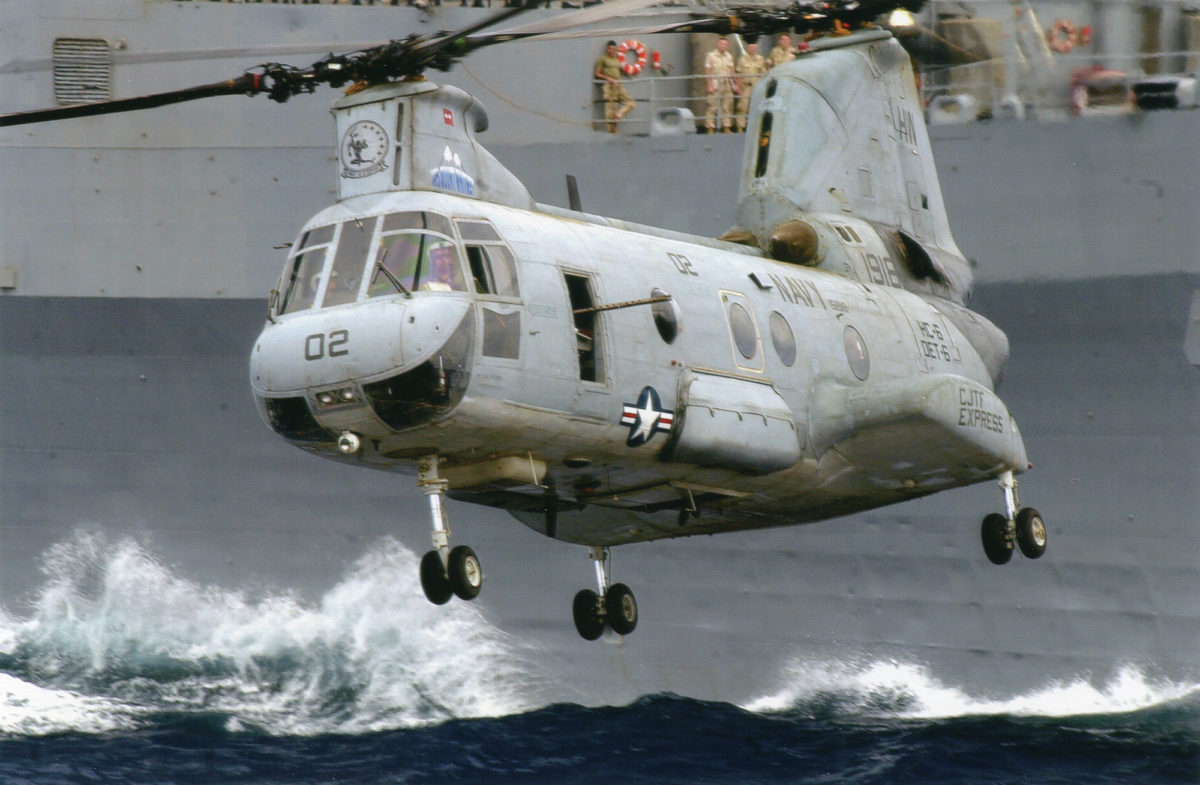Boeing Vertol’s CH-46 was recently retired from active duty after 50 years of service. The final three U.S. Marine Corps squadrons of Sea Knights, known to leathernecks as “Battle Phrogs,” began transitioning to the MV-22 Osprey starting in February 2014, with another CH-46 dispatched to the “boneyard” at Davis-Monthan Air Force Base every few weeks. The U.S. Navy, which long depended on the CH-46 as a vertical replenishment transport, had retired its last Sea Knight a decade earlier, in 2004. For many CH-46 veterans, however, nothing can take its place.
The Sea Knight dates back to 1956, when Vertol, formed out of the Piasecki Corporation, was looking for a major project. The result was the Model 107M (military HRB-1), a tandem-rotor, stressed-skin helicopter powered by the new T58 1,250-hp turbine engine. After Boeing took over Vertol, the design went through years of refinements. The Marines awarded a contract in February 1961, after a competition was held for a new combat assault/utility transport helicopter. Thereafter the Navy also jumped in to purchase the CH-46. The first production model flew on October 16, 1962, with deliveries beginning in 1964.
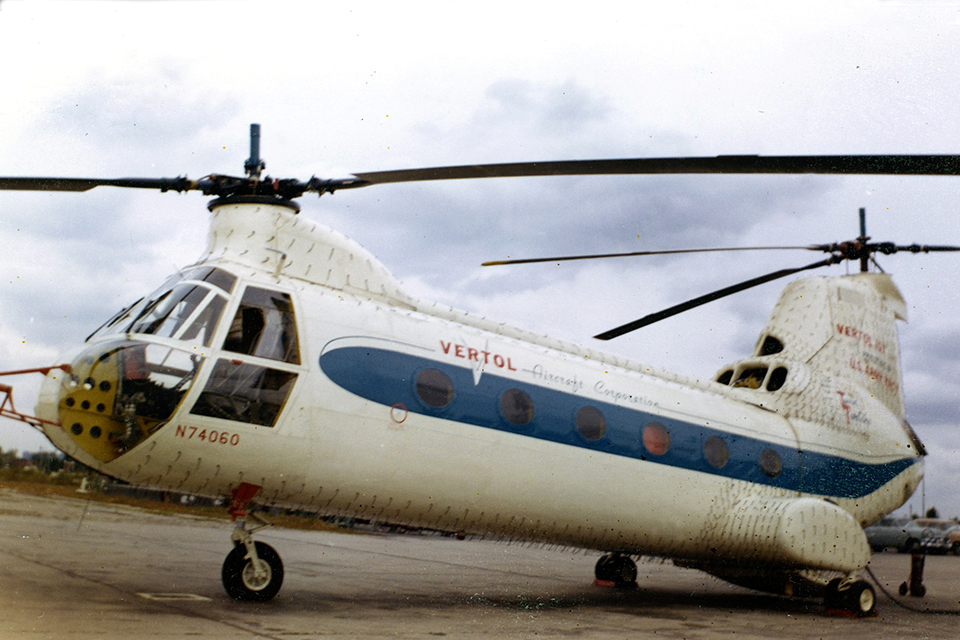
Problems plagued the early models, leading to fatal accidents in Vietnam as well as Stateside. Following a CH-46 Reliability Review Conference in August 1967 at the Vertol plant in Pennsylvania, the aft rotor assembly was redesigned. The modified chopper eventually gained an overall favorable reputation during the Vietnam War years, when it became a familiar sight on the nightly news. Replacing the UH-34 Seahorse, it served as the main troop carrier for the Marines, arriving in-country in March 1966.
Retired Colonel Fred Allega, who first flew the CH-46 at Marine Corps Air Station New River on November 3, 1964, remembered: “The first pilots were all factory-trained….We had four to five days of ground school, then we went out with an instructor pilot. Since I was a senior first lieutenant and an aircraft commander, I never had much copilot time. Unfortunately, the 46A models were very underpowered.”
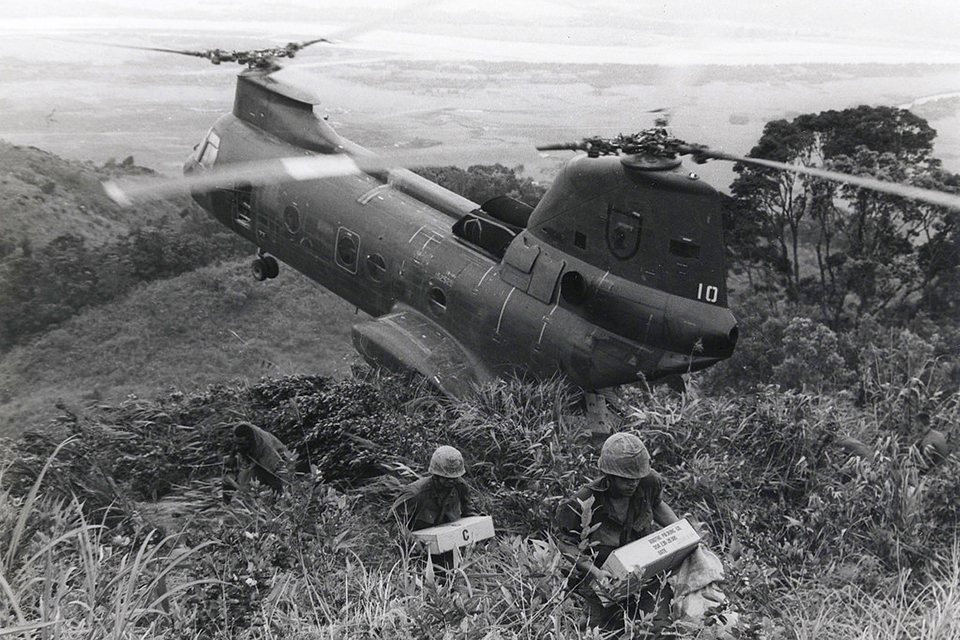
During the Vietnam War, Allega received two single-mission Air Medals to go with his two Distinguished Flying Crosses and 25 regular Air Medals. The first medal was awarded for a mission to Laos, to recover a Special Forces team trapped on a mountainside—two Americans and four Vietnamese Montagnards surrounded by the enemy. “We would go out to put these teams on the Ho Chi Minh Trail, and usually we were back in less than four hours to pull them out because they would get into trouble,” Allega said. “This time it was a really big show—we had two gunships and some ADs [Douglas Skyraiders] as support. There was no place to land, so we had to use the hoist. Nobody got shot down, but they all took a lot of hits. We got shot up pretty well, too. It was a constant gun battle, and none of their team expected to survive….when one of the Americans was back on board, he hugged me. The Army actually recommended me for the medal.”
In the second mission, an Army team had come under fire near Da Nang close to nightfall. Allega recalled: “We extracted them under fire again. We had gunships for cover, but this time was not as bad. The team had so many soldiers that we didn’t have enough power to get over the hill once we had picked them up. I did a wingover and went back across the landing zone—something you’re never supposed to do. We took 20mm fire, and realized that one guy was still on the rope. He had to hold on for 15-20 miles, until we were halfway home. He got to the hatch, and had so much equipment on that he wouldn’t fit. One guy in the helicopter had to reach out with a knife and cut away his gear, then he fit inside.
“When you are done, you are just happy to be alive,” he added. “You did your mission and didn’t worry about medals.”
While the CH-46 was primarily used as a transport, it was equipped with some armor—mostly to protect the engines and avionics bays. The side windows were removed in Vietnam, and .50-caliber machine guns mounted at both side hatches. “We were usually told where we could shoot—if we were in ‘Indian Country,’” Allega said. “Otherwise it was pretty restricted, since we did not always know where the friendlies were.”
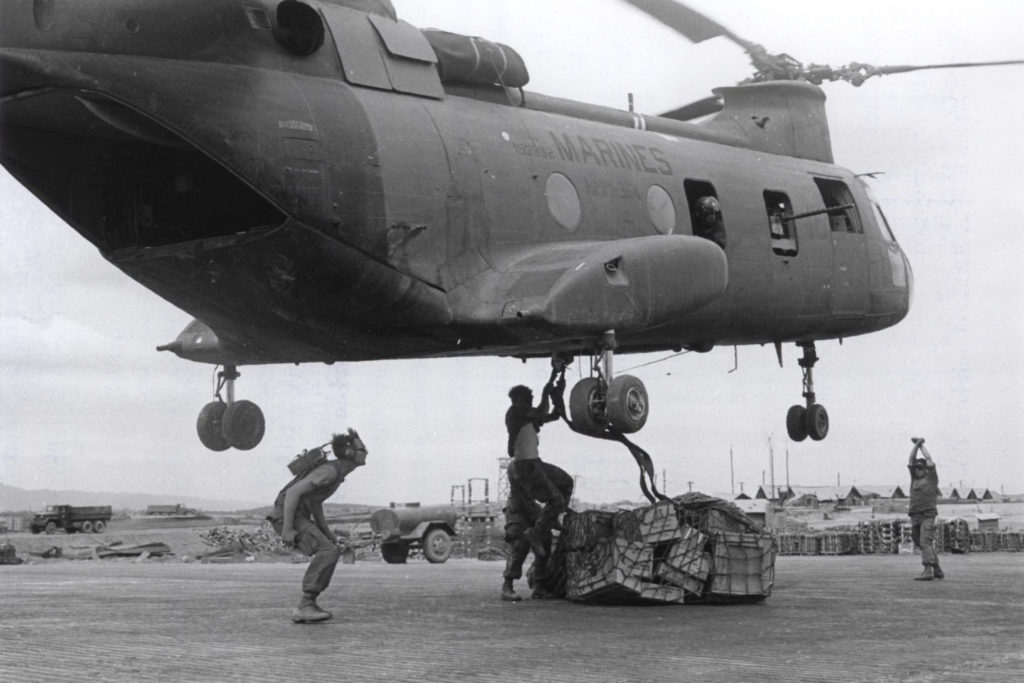
The conflicts in Iraq and Afghanistan also saw widespread use of the CH-46. Marine Major Dominic Harris, who served as the aircraft maintenance officer for the last Sea Knights at MCAS Camp Pendleton in Southern California, was deployed to Iraq from 2003 to 2006, and again in 2007-08. “I was usually flying CASVAC [casualty evacuation], along with some ground support and on occasion VIP duty,” Harris said. Despite all the flying he did in a hostile environment, he noted: “I was never hit, at least not that I knew, but I got lucky. My first mission—in the opening days of the war—I was stationed forward. We would go out in pairs a week at a time. Most of it was CASVAC support, and I was with Colonel (now General) [Joseph F.] Dunford helping the medevac guys. We got a call in the morning to go in between the U.S. and British artillery units. There were Scud [missile] warnings; we had to cross the border and didn’t know what to expect.
“A couple of foot soldiers…had stepped on mines and needed to be evacuated. We were still an inexperienced crew, and we flew to the vicinity. A bunch of people were lying on the ground, and there were Marines all around. We saw the landing panels and tried to focus on them, but it kept going through my mind, ‘What if those are body bags?’ We had not heard how the invasion was going, and it turned out those were Iraqi prisoners lying on the ground, hands bound with zip ties, and Marines guarding them until they could be processed.”
In those early days of the war, there was a lot of confusion, and “adrenaline was running pretty high,” Harris said. “The medevac was near the first line of Iraqi defense, and it turned out there were lots of surrenders right away—they had no food and were ready to surrender!”
Major Jeff Barber wanted to fly helicopters when he joined the Corps 15 years ago, and he got his wish. “I was deployed to Iraq from June of 2004 to March 2005, and also the spring of 2006,” he said. “My usual missions were CASVAC, ammo resupply and just plain logistics—moving people and things. Our scariest mission: We were shot at a lot, but one time a SAM was shot at us. We were in a dash-2 aircraft, and the lead aircraft saw the launch and the missile tracking our aircraft. We shot our flares, not knowing if it was a real situation, as there were lots of false alarms, but this time it hit the flares and exploded below us. I guess ignorance was bliss. We still use flares like that.
“Another time we were flying over the ‘wrong’ part of Baghdad. Every time this would happen, we would get shot at a lot, but we usually would not find any holes in our aircraft. This time, the lead aircraft was lost—he had holes, we didn’t!”
Regarding his aging mount, Barber said: “I didn’t really think about the age of the aircraft; everything has been upgraded. It is old but reliable, simple and you know how it operates. It is kind of like an old baseball mitt—comfortable, and it gets the job done….We do have HUD [head-up display] for navigation equipment….It may have the same serial numbers, but it is not the same aircraft that was in Vietnam.”
Captain Sean Breit-Rupe, who joined the Marines in June 2005, has been flying for six years. “I have only flown 46s—‘God’s Chariot’—and I have nothing but pride in the old girl,” he said. “It is reliable and will go anywhere. You can see the gauges and they tell the answer—no pushing buttons. If it isn’t leaking, it is out of fluids, and you don’t need a computer to tell you it doesn’t look, smell or feel right. You just know.”
While in Iraq from March to October 2009, Breit-Rupe mostly flew troop transport, cargo and VIPs. He remembered that “things were winding down, and it was a lot calmer. We were bringing guys back from bases that were closing, and flying Iraqi nationals to the forward bases—no more flying CASVAC….We did get shot at a couple of times at Ramadi—we had to make a tight turn and went over a bad neighborhood. We didn’t know for sure until we were on deck and saw the holes. At one checkpoint we always drew tracers. We finally figured out it was one guy with an AK-47 who was tired of helicopters flying over. We could never tell if it was a false alarm; you had to break away from the threat.
“My final deployment wasn’t as bad. You would fly over the Tigris, the Euphrates and Babylon, and the history wasn’t lost on you. We were flying over ancient battlefields, but we never got to do sightseeing, only from the air. We were based at the Al Asad base, and we served with heroes—the guys that were there early. I was just cleaning up. They flew their brains out.”
One of Breit-Rupe’s most memorable tales concerned a recent delivery mission: “I have flown some 46s to Davis-Monthan. Kevin Rector flew one retired bird over there, and when he tried to shut down, it wouldn’t stop. He pulled back the throttles and cut everything off, and it was a dual engine control failure. Fuel kept getting to the engines. He tried to ‘beep’ the engines down, popped the handles for a fire, and it still wouldn’t stop. They even did a manual fuel shut-off, and it still ran for 15 minutes. She didn’t want to quit!”
Commanding officer Lt. Col. Brian Peterson, who piloted CH-46s in Afghanistan, recalled: “I have been flying it for 19 years, and in Afghanistan I first flew recon in the mid-2000s. Later I flew CASVAC in the Sunni triangle area. We were then deployed to WESPAC [Western Pacific], flying off ships, where we won ‘HMM of the Year.’”
Peterson explained: “In Afghanistan, during the initial invasion, we were just getting a foothold. We were supporting ‘carjacking’ missions outside of Kandahar, where we set up checkpoints and flew in supplies to the guys on the roads. This was late in 2001, and we were back out in 2002. They never brought any more CH-46s in there; there were only two squadrons to begin with. One squadron had been sent in from the West Coast—HMM-163—and one from the East Coast.
“Our most difficult missions were the low-level, low-light flights at night in the desert environment. There was always very fine dust flying, and a Huey crashed from the brownout. We were never shot at, though. In Iraq we took lots of shots, usually when we were traveling at night.” He added, “I never worried about how old the aircraft were because nothing is going to go wrong in a 46 that hasn’t happened before.”
Captain Steven Dixon, who has been flying CH-46s for the last five years, reflected on his experience in the venerable bird’s most recent training role. “Our average day starts about 0645, and ends about 12 hours later,” he reported. “It includes about three hours of flying, and we do it two or three times each week for each crew. We practice our main skills—landings and navigation, that’s pretty typical. When we do night flights, the days are only about 10 hours long. Despite our names being on the sides of the aircraft, we aren’t actually assigned a particular 46. Neither are the crews—they work on them all.”
Dixon also flew overseas, though not in active war zone duty: “We were deployed on the USS Makin Island, 12 46’s, five Zulu Cobras, four 53s, two Hueys and six Harriers—29 aircraft total. We made a couple of transits of the Strait of Hormuz, went to Kuwait, Jordan, Bahrain, Saudi Arabia. Before that the squadron had been in Iraq.”
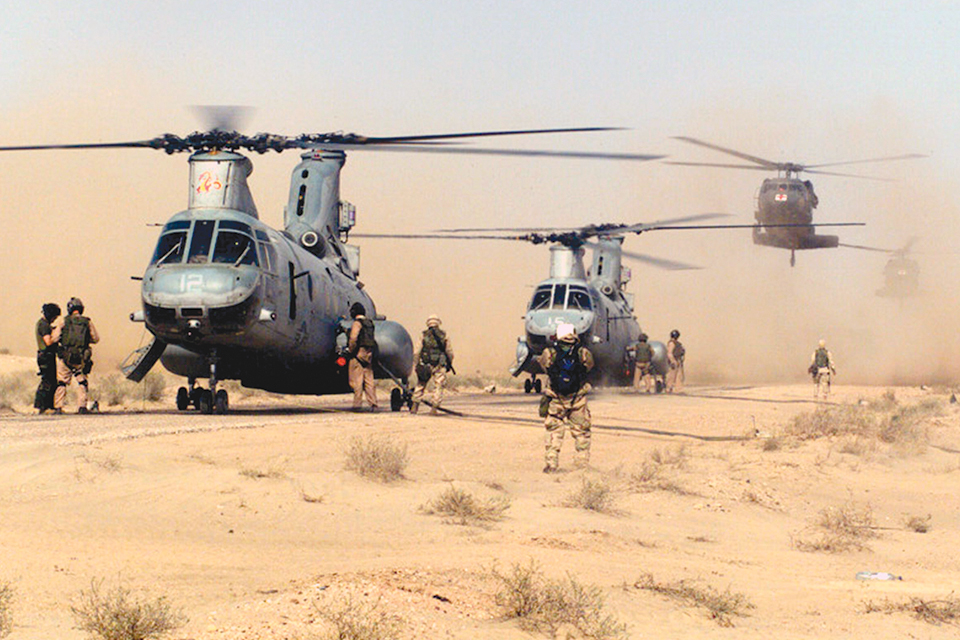
Captain Allen Whitlow, who was preparing to take his next to last flight in a Battle Phrog before transitioning to the Osprey, said: “I always wanted to fly helicopters. The CH-46 is like an antique car. We do have HUD with the helmets, but basically it is still the stock instruments.”
Whitlow noted the care taken with the aging Sea Knights: “Most of our flying is at 70-80 knots. At the end of every 30 hours of flight, we collect oil and transmission fluid samples. They look for metal, and can tell if it is from bearings, seals, etc. Every 100 hours there are phase inspections—A, B and C—with different sections of the aircraft being inspected. It is still the basic airframe, but the transmission, engine and many components have been changed numerous times. So for everything except the airframe, it is a newer helicopter. I will always have a soft spot for the CH-46 as it is being retired.”
The crews that kept the Sea Knights flying have a similar perspective. Crew chief Staff Sgt. James Barnhill said that the biggest challenge with an aircraft that age is just “keeping it safe to fly.” His motto is “never trust a helicopter under 40 years old.” Corporal Joseph Moccia, who works with Barnhill, said he “finds the age of the aircraft comforting.”
Corporal Michael Petruny, a crew chief who worked on CH-46s for a year, noted, “The biggest challenge is to keep up with it; it is good overall, but it has its quirks.” Corporal Harrison Schoettley agreed, saying: “The typical repairs have been done many times; the biggest problems are just keeping up with metal fatigue, the hydraulics, the tires and fiberglass areas. Those kinds of repairs always need to be redone. There isn’t much bullet-hole patching anymore….”
The CH-46 has undergone a lot of modernization to keep it flying all these years. The first major round of improvements—to 273 aircraft—came in 1983, involving engine upgrades (to 1,800 hp) as well as modifications affecting rescue gear, avionics and crash survivability. By 1999, another round of mods improved night flying capabilities and included many dynamic component upgrades.
Recent aircraft survivability upgrades have added new countermeasures, including a new missile warning system, redesigned chaff and infrared missile jamming. Some of the extremely heavy steel armor plate previously installed was replaced with the new ceramic version. Despite all that, the interior remains very old school, with lots of hydraulics and bundles of wiring.
Most of the last flying models were the CH-46D/E versions, which typically carried a crew of three or four and could haul up to 25 passengers or, for casualty evacuation, 15 litters and two medical attendants. During Desert Storm the CH-46 regularly flew replenishment missions while maintaining a mission-capable rate of 87 percent.
Sea Knights were last deployed overseas in May 2010, on the amphibious assault ship Peleliu bound for the Persian Gulf. At the beginning of 2014, three squadrons were still flying the CH-46—two out of Camp Pendleton and one in Norfolk, Va. HMM-364 had 14 of the veteran helicopters left, HMM-774 had 12 and a handful were being used by HMMT-164, a training squadron.
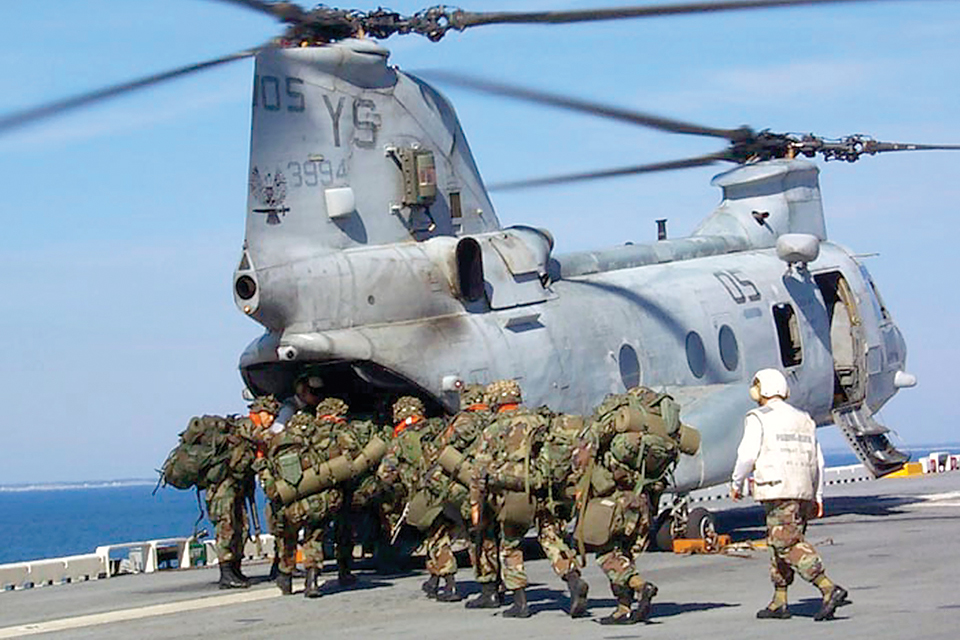
Several of the old warbirds are still scattered in other locations, including 14 at Twentynine Palms, in California. A few more are thought to be languishing at overseas bases, likely being used as squadron hacks.
HMM-774, in Norfolk, was the first to transition to the MV-22 Osprey, in February 2014. HMMT-164, at Camp Pendleton, wrapped up its CH-46 days on August 25.
The annual airshow at Marine Corps Air Station Miramar near San Diego on October 3-5, 2014, was initially supposed to feature a few CH-46s in its Marine Air-Ground Task Force demonstration, but the decision was made to highlight the Osprey instead. In the CH-46’s last public flight demonstration, four Battle Phrogs made a couple of passes over the field at Miramar before heading off into history. A few days after that show, on October 9, the commander of HMM-364, Lt. Col. John Field, relinquished his command at Camp Pendleton, and the unit was redesignated as Tilt Rotor Squadron 364.
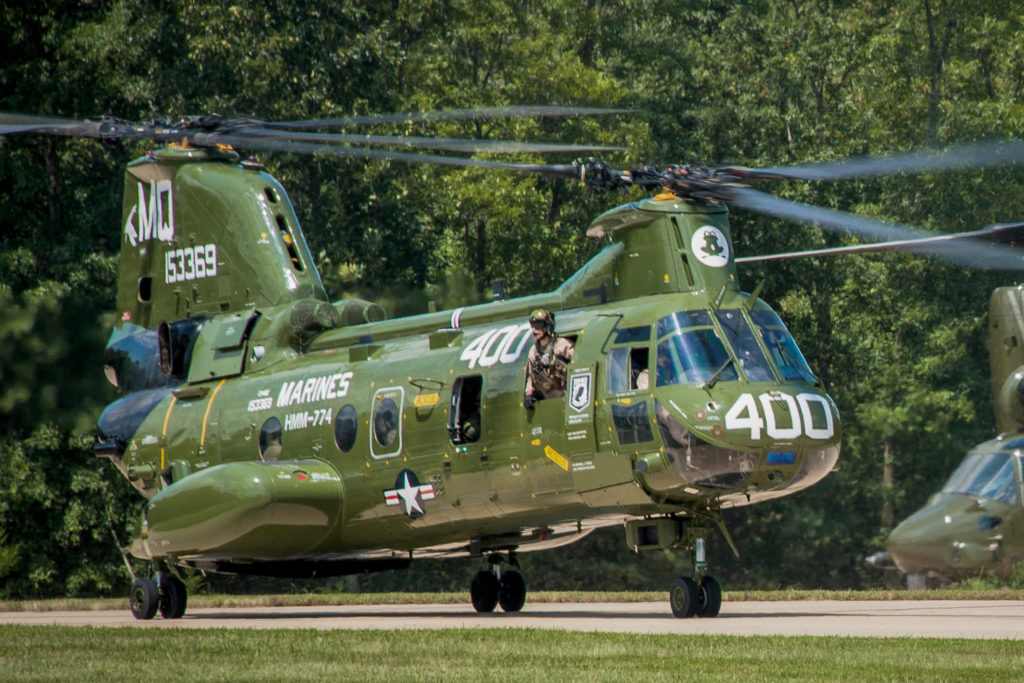
Many CH-46 veterans attended the October 9 Camp Pendleton ceremony, including famous Phrog pilot Major Pat Donovan, who earned two Navy Crosses in the span of two months in 1969. In February of that year he was seriously wounded while evacuating casualties under heavy fire in Vietnam’s Quang Nam Province. Despite his wounds, once he determined that his damaged chopper was still airworthy, he returned to evacuate more wounded troops. Then in April Donovan again came under heavy fire during another casualty evacuation mission in the same region. His CH-46 was so badly shot up that it was deemed no longer airworthy. Nevertheless, he found another chopper and requested another mission to the same landing zone, where more wounded troops remained. Once again his CH-46 came under intense fire, wounding his door gunner. Although another helicopter had to finish off the mission, Donovan made it back to base. His daughter, Captain Eileen Donovan—a former CH-46 pilot who now flies the Osprey—flew an MV-22 to Camp Pendleton to witness the October ceremony.
It will take about a year for all the remaining CH-46s in Virginia and California to be retired to the Arizona boneyard. Most of the Sea Knight’s roles are being passed on to the Osprey, but the Sikorsky SH-60 Seahawk is also taking on some of its duties. Meanwhile those who flew or maintained the venerable Battle Phrog rightfully have the final word about its legacy. Most claim they wouldn’t have traded it for any other helicopter—not in Vietnam, Iraq or Afghanistan.
Historian Frank Lorey III is the author of 15 books and more than 500 magazine and journal articles. While researching this article, he spent a day flying in CH-46s with the Marines at Camp Pendleton, and another day conducting interviews prior to their retirement ceremony. He also interviewed crewmen before the final public flight demonstration at MCAS Miramar. A video of the last mass CH-46 flight at Camp Pendleton can be viewed on YouTube (search “Mass Formation CH-46”).
This feature originally appeared in the July 2015 issue of Aviation History. To subscribe, click here!
Ready to add a “Battle Phrog” to your own collection? Click here for our exclusive model review!

